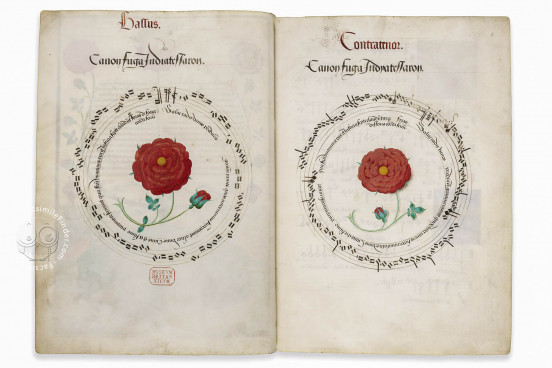This music manuscript was created in Antwerp under the guidance of Petrus de Opitiis, a Flemish-Italian merchant, in 1516. It was presented to King Henry VIII of England by 1518. The work contains eight separate pieces by three authors: two elegiac poems in honor of Henry VIII by a “Magister Sampson” and Johannes de Opitiis and six motets by the same Magister Sampson and Benedictus de Opitiis. Its seventeen large-format parchment folios are expertly produced and decorated throughout.
The most spectacular illumination is a full-page frontispiece acting as a framing element for the initial elegiac poem, which celebrates the union of the English royal houses of York and Lancaster. The Latin poems and motets are presented with their musical notation for up to four voices in a late Gothic hybrid script. Ornate gilded acanthus initials and Gothic cadels decorate individual pieces. It is a grand choir book fit for a king and is a spectacular example of Northern Renaissance manuscript production.
In Praise of the Tudor Dynasty
The principle illumination in the manuscript is a full-page allegorical frontispiece. The central poem presented in two columns is surrounded by a stylized Tudor rose bush bearing three blooms. It springs from the center of a circular island enclosed by a crenelated wall with four round towers.
Every detail of the image is symbolic, from the daisy and marigold representing King Henry’s sisters, Margaret of Scotland and Mary of France, respectively. The central gatehouse is guarded by the lion of England and flanked by the Tudor dragon and the Beaufort greyhound. It has survived in beautiful condition and is an exquisite example of Tudor illumination.
Majestic Musical Manuscript
King Henry VIII of England was a lover of music, made apparent by the grandeur of this choir book. The large pages are expertly designed and presented, each piece introduced with exquisite gold acanthus initials sprouting red roses in fields of vibrant colors.
Subordinate motets are embellished with Gothic cadels. The late Gothic hybrid script is expertly written and the musical notation is regular and experienced.
Melding of Late Gothic and Northern Renaissance
Although the printing press was already in use throughout Europe, manuscripts on parchment continued to be produced through the first half of the sixteenth century often incorporating traditional Gothic design with Italianate style.
This work combines Gothic design elements like gilded initials and cadels with Northern Renaissance styled naturalistic flowers and perspective. This reflects its creation in the early sixteenth-century by Petrus de Opitiis in Antwerp for an English audience.
The book was presented to Henry VIII by 1518 and remained in possession of the English crown until it entered the British Museum as part of the Old Royal Library in 1757.
Binding description
The original binding is lost. The current binding dates from after 1757. The white parchment over wood is tooled and gilt with a patterned border surrounding the royal arms of George II with marbled endpapers.
We have 1 facsimile edition of the manuscript "Music for King Henry VIII": Music for King Henry facsimile edition, published by The Folio Society, 2009
Request Info / Price








